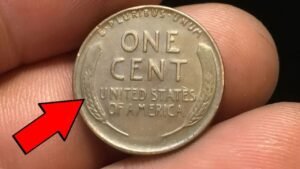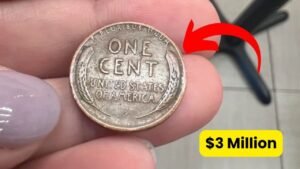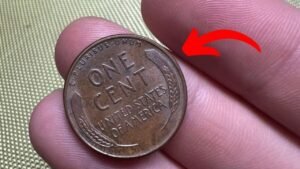A Coin Born in 1909
The Lincoln Wheat Penny first hit American pockets in 1909, celebrating the 100th anniversary of President Abraham Lincoln’s birth. Designed by sculptor Victor David Brenner, it was a groundbreaking moment in U.S. coinage—the first time a real historical figure graced a circulating coin, moving away from symbolic images like Lady Liberty. The coin’s obverse features Lincoln’s profile, while the reverse showcases two wheat stalks framing “ONE CENT,” earning its nickname “Wheat Penny.”
From 1909 to 1958, billions of these pennies circulated, becoming a staple of American commerce. Most are worth just a cent or two today, but certain rare varieties, like the 1943 copper penny, have skyrocketed in value due to their scarcity and historical significance.
The Wartime Error That Created a Legend
During World War II, copper was a critical resource for military supplies like ammunition and wiring. To conserve it, the U.S. Mint switched to zinc-coated steel for pennies in 1943, producing the so-called “steelies.” However, a few copper planchets (blank coin discs) from 1942 were accidentally left in the presses and struck with 1943 dies. This mistake created the ultra-rare 1943 copper penny, with only about 20 authenticated specimens known today across all three U.S. mints (Philadelphia, Denver, and San Francisco).
One such penny sold for $1.7 million at auction in 2010, and experts estimate a pristine specimen could fetch $5 million or more today, depending on condition and market demand. Its rarity, historical context, and the sheer luck of its creation make it a numismatic holy grail.
Why Is the 1943 Copper Penny So Valuable?
Rarity: A Tiny Number Survive
The 1943 copper penny’s value stems from its extreme scarcity. With only 15 to 20 genuine examples known, it’s one of the rarest coins in American history. Compare that to the billions of steel pennies minted that year, and you see why collectors go wild for it. Each authenticated coin is a unique piece of history, often fetching seven-figure sums at auction.
Historical Significance
This penny isn’t just rare—it’s a tangible piece of World War II history. The accidental use of copper during a time when every ounce was needed for the war effort adds a layer of intrigue. Collectors value coins that tell a story, and the 1943 copper penny’s tale of human error during a global crisis is irresistible.
Condition Matters
In coin collecting, condition is king. A 1943 copper penny in “mint state” (near-perfect condition) could command $5 million, while a worn example might still fetch hundreds of thousands. Professional grading services like PCGS (Professional Coin Grading Service) or NGC (Numismatic Guaranty Corporation) assess coins on a scale from Poor to Mint State 70, with pristine coins fetching the highest prices.
How to Spot a Valuable Lincoln Wheat Penny
The Magnet Test
Want to check if your 1943 penny is the real deal? Grab a magnet. Steel pennies from 1943 will stick to it, but the rare copper versions won’t. This simple test is a quick way to rule out most fakes, though professional authentication is essential for confirmation.
Key Dates and Mint Marks
Beyond the 1943 copper penny, other Wheat Pennies are worth hunting for:
- 1909-S VDB: Only 484,000 were minted in San Francisco, with designer Victor David Brenner’s initials on the reverse. A well-preserved example can fetch $100,000 or more.
- 1914-D: A low-mintage coin from the Denver Mint, valued at $30,000–$50,000 in good condition.
- 1922 No D: A Denver-minted penny missing its “D” mint mark due to a worn die, worth thousands.
- 1955 Doubled Die: A minting error causing a doubled date and lettering, valued at $1,000–$2,000 even in worn condition.
Look for mint marks (“S” for San Francisco, “D” for Denver, or none for Philadelphia) below the date on the obverse.
Weight Check
A 1943 copper penny weighs about 3.11 grams, while steel pennies weigh around 2.7 grams. A precise scale can help confirm a coin’s composition before seeking professional grading.
Real-Life Discoveries: Stories of Found Treasures
The allure of the Lincoln Wheat Penny lies in its potential to be found in everyday life. In 1987, a Massachusetts teenager discovered a 1943 copper penny in his high school cafeteria change, later authenticated and valued at over $40,000. More recently, a New Jersey man found a 1909-S VDB penny in a family coin jar, selling it for $75,000 at auction. These stories fuel the modern-day treasure hunt, proving that life-changing finds are still possible.
Tips for Protecting Your Potential Treasure
If you think you’ve found a valuable penny, handle it with care:
- Don’t Clean It: Cleaning can ruin the coin’s patina and reduce its value significantly.
- Hold by the Edges: Use cotton gloves or hold the coin by its edges to avoid oils from your skin damaging the surface.
- Store Safely: Place the coin in a PVC-free holder to protect it from moisture and scratches.
- Get It Authenticated: Contact PCGS or NGC for professional grading. Their certification ensures authenticity and maximizes value.
The Thrill of the Hunt
The possibility that a $5 million penny could be hiding in your change jar or pocket adds excitement to the mundane act of handling coins. Coin collecting, or numismatics, isn’t just about money—it’s about connecting with history. Each Wheat Penny carries stories of its era, from the Great Depression to World War II. Whether you’re hunting for a million-dollar rarity or building a modest collection, the journey is rewarding.
Online communities like the PCGS CoinFacts forum or Reddit’s r/coins let enthusiasts share finds and tips, fostering a sense of camaraderie. Schools have even used Wheat Pennies to teach history, showing how small objects reflect big moments.
Could You Have a Million-Dollar Penny?
The next time you empty your change jar or get coins at the store, take a moment to check those pennies. Look for key dates like 1943, 1909-S VDB, or 1914-D. Use a magnet and a scale to narrow down possibilities. While finding a $5 million penny is a long shot, even lesser-known Wheat Pennies can be worth hundreds or thousands.
Valuable Lincoln Wheat Pennies to Watch For
| Year | Mint Mark | Error/Feature | Estimated Value | Key Identification |
|---|---|---|---|---|
| 1943 | D, S, or None | Copper (not steel) | Up to $5 million | Non-magnetic, 3.11g |
| 1909 | S | VDB initials | $50,000–$100,000 | “S” below date, “VDB” on reverse |
| 1914 | D | Low mintage | $30,000–$50,000 | “D” below date |
| 1922 | None (Denver) | No “D” mint mark | $10,000–$50,000 | No mint mark |
| 1955 | None | Doubled Die | $1,000–$2,000 | Doubled date/lettering |
FAQs About the Lincoln Wheat Penny
How can I tell if my 1943 penny is copper?
Use a magnet. If it doesn’t stick, it might be copper. Weigh it (should be ~3.11 grams) and seek professional grading from PCGS or NGC.
Are all Lincoln Wheat Pennies valuable?
No, most are worth a few cents. Only specific years, mint marks, or errors (like 1943 copper or 1909-S VDB) command high values.
Where can I find rare Wheat Pennies?
Check pocket change, old coin jars, inherited collections, or bank rolls. Flea markets and estate sales are also good spots.
Should I clean my penny to check its value?
Never clean a coin—it can ruin its value. Handle it by the edges and store it in a protective holder.
How do I get my penny authenticated?
Contact reputable grading services like PCGS or NGC. They’ll verify authenticity and assess condition, providing official certification.
Final Thoughts
The Lincoln Wheat Penny valued at $5 million is more than a coin—it’s a piece of American history with a story that captivates collectors and dreamers alike. Its rarity, wartime origins, and the chance it’s still out there make it a symbol of hidden treasure. So, next time you see a penny, take a closer look. You might just hold a fortune in your hand.
Disclaimer: Coin values fluctuate based on market conditions. Always consult professional numismatists for accurate appraisals. Information sourced from numismatic research and auction records.




